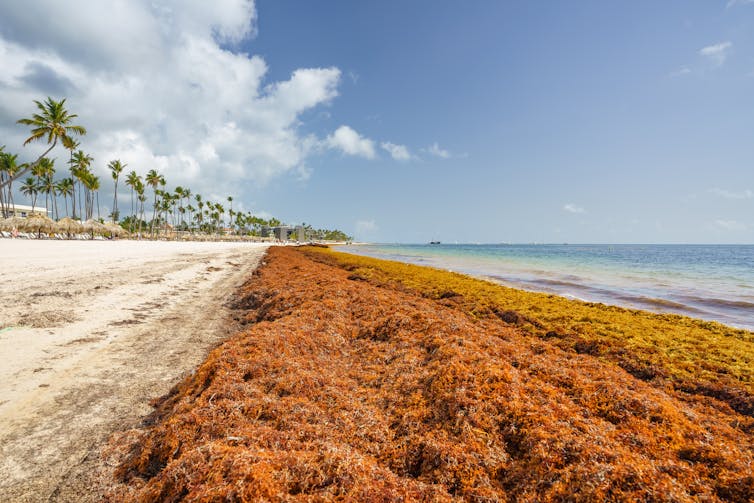
by University of Southampton
As Atlantic beaches brace for their annual onslaught of a potent-smelling seaweed, scientists on a project led by the University of Southampton are sharing their research into how communities affected can make use of this putrid problem – by turning it into a compost.
The team has also developed an early warning system so affected communities can prepare.
Vast rafts of sargassum seaweed are wreaking seasonal havoc on coastlines across the Tropical Atlantic. Millions of tonnes of sargassum – and increasing annually – are washing up on beaches from Mexico to Africa, threatening fishing, tourism and ecosystems, including turtles who cannot get onto the beaches to lay their eggs.
Until 2011, sargassum was contained to the Sargasso Sea, off the coast of Bermuda. Its spread south into warmer waters where it is thriving was initially driven by an unusual weather event, but it is now pushed across the tropical Atlantic Ocean by winds, currents and changes in the Atlantic Meridional Mode (the way in which the ocean moves). Huge rafts of the seaweed are visible from space, and 2023 is predicted to be another severe year.
The Southampton-led research project (which collaborated with the University of York, the University of Ghana, and the University of the West Indies in Barbados and Jamaica) has found sustainable uses for the seaweed. These include as compost to support mangrove re-growth and for growing peppers and tomatoes.
The project team has also created resources for schoolteachers in Ghana to support them with teaching the identification of sargassum and uses for it, and has set up an early warning system for Jamaica, which it is hoped will be rolled out to west Africa. The system combines geospatial and socio-economic data to advise when and where sargassum will wash up, enabling communities to prepare for clean-ups and to manage its impact.
The academics involved are coming together in Southampton this week to present their findings to peers and policymakers.
Project lead Emma Tompkins, Professor of Geography, Environment and Development at the University of Southampton, said: “When sargassum washes ashore, it can pile metres high and can be devastating. As it decomposes it stinks, can cause skin irritations and it gives off hydrogen sulphide that can cause breathing difficulties. It’s affecting fishermen’s ability to fish, it’s affecting tourism, and it’s a problem for ecosystems, particularly for turtles that go to lay their eggs on beaches in the summer when sargassum is at its worst.”
Stay Always Informed
Join our communities to instantly receive the most important news, reports, and analysis from the aquaculture industry.
Working under funding from the Global Challenges Research Fund, the project team has established ways for the poorest people affected by sargassum to use it.
Professor Tompkins said: “Rather than industrial-scale collection, we have looked at how sargassum can be used by coastal communities and small-scale farmers. Successful uses include supporting mangrove growth, and as compost for growing peppers and tomatoes which are important crops for poorer communities.”
Editor at the digital magazine AquaHoy. He holds a degree in Aquaculture Biology from the National University of Santa (UNS) and a Master’s degree in Science and Innovation Management from the Polytechnic University of Valencia, with postgraduate diplomas in Business Innovation and Innovation Management. He possesses extensive experience in the aquaculture and fisheries sector, having led the Fisheries Innovation Unit of the National Program for Innovation in Fisheries and Aquaculture (PNIPA). He has served as a senior consultant in technology watch, an innovation project formulator and advisor, and a lecturer at UNS. He is a member of the Peruvian College of Biologists and was recognized by the World Aquaculture Society (WAS) in 2016 for his contribution to aquaculture.



